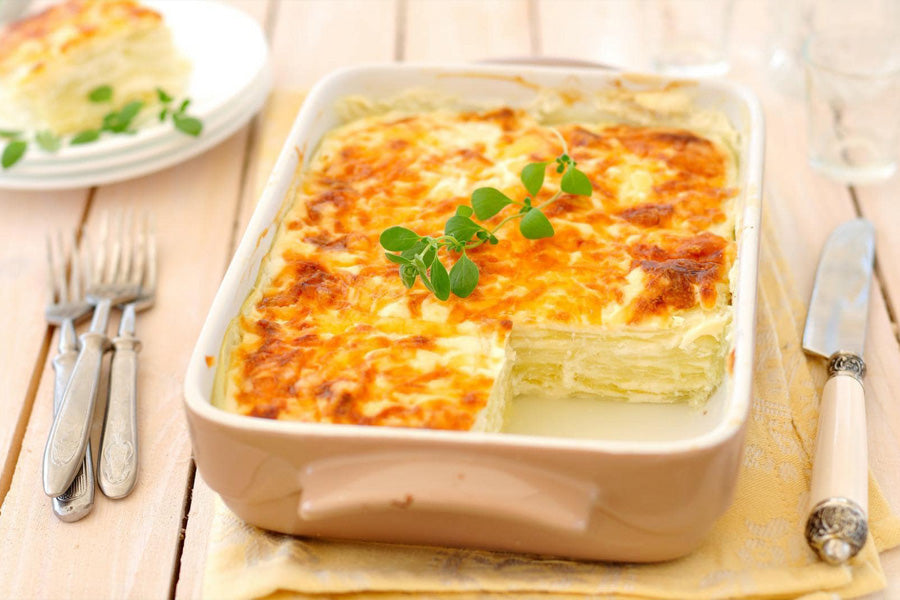Are you a die-hard lasagna lover but feeling guilty about the extra calories and fat that come with every cheesy bite? Well, I have some good news for you! Today, I'm here to share a low-calorie lasagna recipe that will have you feeling satisfied and guilt-free.
I used to think that the only way to make lasagna taste amazing was to pile on layers of full-fat cheese and meat. But then, I discovered this recipe that uses fat-free cheese, low-fat beef, and frozen spinach to give you all the flavor and protein you crave without the added calories. And the best part? This recipe calls for whole wheat lasagna noodles, so you can feel good about indulging in some whole grains too!
So, if you're ready to dive into a delicious and healthy twist on the classic lasagna, let's get cooking!
Related Article: The Best Recipe for Deer Burgers (Venison Burgers)
|
Servings |
12 Persons |
|
Preparation Time |
10 Minutes |
|
Baking Time |
40 Minutes |
|
Total Time |
50 Minutes |
Nutritional Facts
|
Calories |
205 cal |
|
Protein |
25.6 g |
|
Carbs |
18.6 g |
|
Fat |
3.6 g |
Ingredients
- 1½ lbs of lean ground beef
- 6 oz. whole wheat lasagna noodles
- 2.5 cups of traditional spaghetti sauce
- 2 cups fat-free cottage cheese
- 9 oz. pkg. frozen spinach (cooked as directed and drain extra water)
- 8 egg whites
- 8 oz. mushrooms
- 1 cup fat-free mozzarella cheese
Instructions
- Cook ground meat in a skillet until brown.
- As specified on the packaging, boil the noodles.
- Spread a few teaspoons of the spaghetti sauce on the bottom of a 9"x13" pan after spraying it with cooking spray.
- Except for the fat-free mozzarella cheese, combine the remaining ingredients.
- Place half of the cottage cheese mixture on top of half the noodles.
- Add the remaining noodles to the layer before adding the second half of the mixture on top.
- Top with fat-free cheese.
- Bake for 35-40 minutes at 350 degrees.
The Story of Lasagna!
There's something about the comfort of a warm, hearty lasagna that just makes my heart sing. From layers upon layers of pasta, cheese, and tomato sauce to the savory and filling meat or vegetable filling, it's a dish that truly has it all.
Whether you're enjoying a homemade version with family and friends or digging into a delicious slice at your favorite Italian restaurant, there's no denying our love for lasagna. It's the perfect mix of comfort food and gourmet cuisine. All wrapped up in one delicious package.
What Does Lasagna Mean?
The word lasagne or lasagna has its roots in Ancient Greece. It is derived from the word "laganon," the first form of pasta consisting of flat sheets of dough cut into thin strips. The early version of this dish lacked traditional Italian ingredients and usually had just layers of pasta and sauce. Similarly, Ancient Rome had a similar dish called "lasanum," which was served in a pot or container. The dish eventually evolved, and it adopted the same name. Twisted macaroni came later.
Lasagna is a single sheet of lasagna and is used regionally across Italy. In northern and southern regions of Italy, people use either lasagna or lasagne, depending on their preference. While British English mostly uses the plural form, American English usually uses the singular version.
It's Savory History
Lasagna, a popular Italian dish many love, originated in Naples, Italy, during the Middle Ages. The first recorded reference to a dish resembling modern-day lasagne was found in a 14th-century English cookbook, which featured a layered pasta dish without tomatoes. Later, an Italian cookbook in the 1880s referenced lasagne with tomato sauce.
Over time, the dish evolved into "Lasagna di Carnevale" in Naples, made with local sausage, fried meatballs, hard-boiled eggs, and ricotta or mozzarella cheese, along with Neapolitan Ragu. Another popular variation, "Lasagna al Forno," originates from the Emilia-Romagna region. It is made with spinach-based green sheets of pasta, ricotta or mozzarella, thick Ragu, bechamel sauce, onion, oregano, and wine.
Lasagna's evolution is not limited to Naples and Emilia-Romagna, as different regions of Italy have their own dish variations, using different doughs and sauces. For instance, Piedmont specializes in lasagna al Sangue, which contains blood from a slaughtered pig and is known as "bloody lasagna."
Why Eating a Lasagna Is Good for You?
It's hard to imagine that the inventor of lasagna could have foreseen its impact on the world today, including its nutritional value. In terms of lasagna's history, one cannot deny how delicious the carbohydrates taste in this dish.
Moreover, it's worth noting that lasagna is loaded with carbohydrates that provide energy to our blood cells and support vital bodily functions daily. While the noodles primarily provide this energy, the sauce and any vegetables added to the dish also contribute in small amounts.
Conclusion
A low-calorie lasagna recipe is a great alternative to the traditional calorie-dense version. By using healthier ingredients and reducing the amount of fat and cheese used, this version of lasagna can help you achieve your fitness goals without sacrificing flavor. Not only is this dish a healthier option, but it's also easy to make and perfect for meal prep or family dinners.
With the right combination of healthy ingredients, you can enjoy a delicious and satisfying meal without the guilt. So why not try making this low-calorie lasagna recipe today and see for yourself how delicious healthy eating can be!











